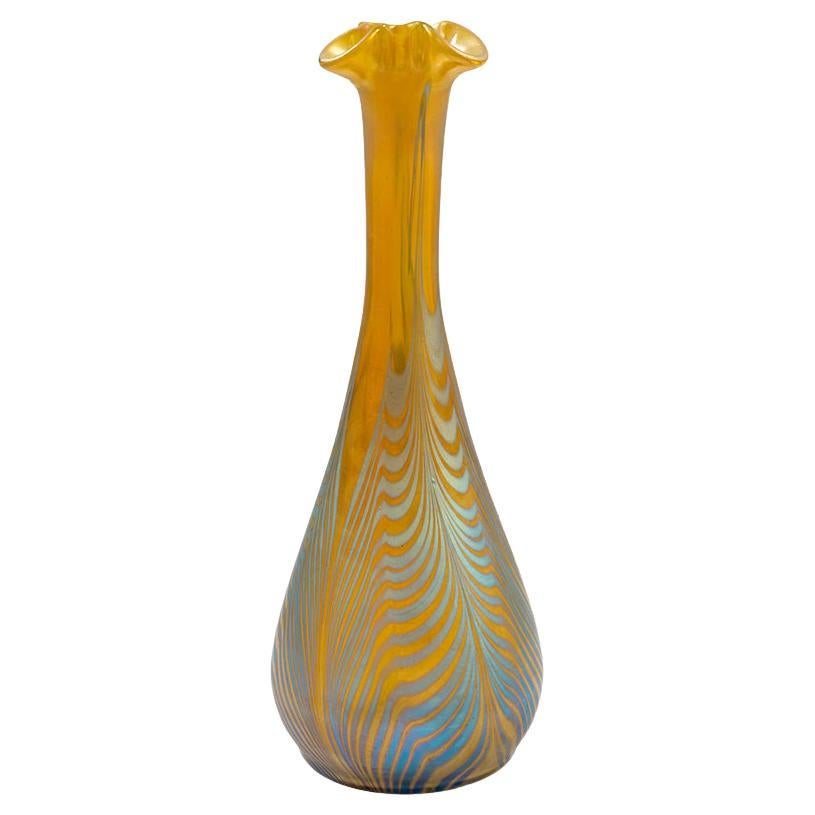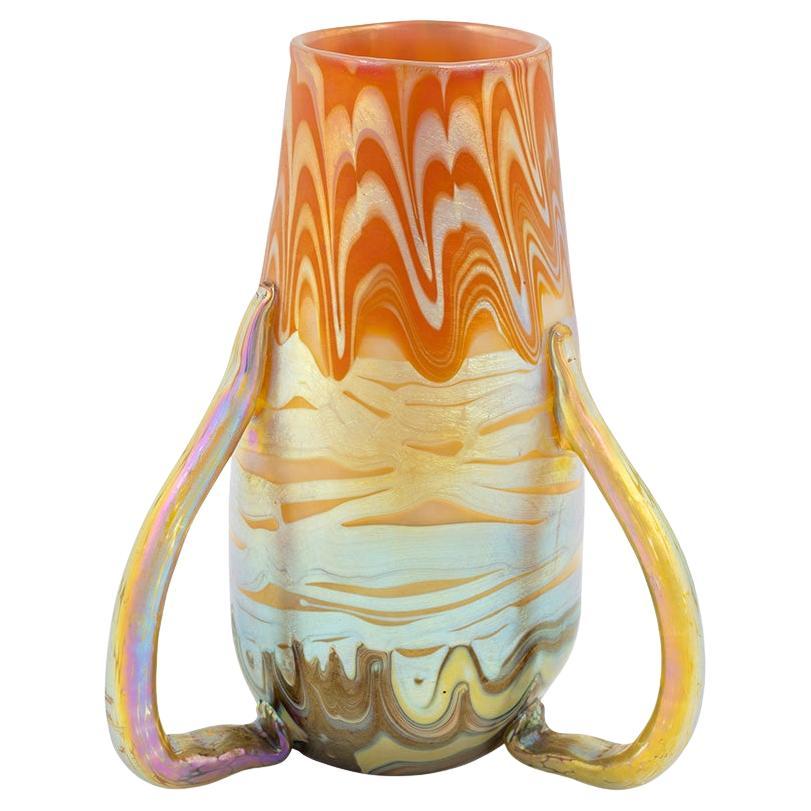Items Similar to Glass Vase Loetz Franz Hofstötter, circa 1901
Want more images or videos?
Request additional images or videos from the seller
1 of 8
Glass Vase Loetz Franz Hofstötter, circa 1901
About the Item
Austrian Jugendstil glass vase decoration by Franz Hofstötter school of Koloman Moser shape/form by Rudolf Holubetz manufactured by Johann Loetz Witwe circa 1901 Phenomen Genre decoration 413
Franz Hofstötter was one of the most famous designers working with Loetz especially because he brought the company the Grand Prix at the Paris World Exhibition in 1900. This vase captivates with its unusual shape and colorful Phenomen Genre 413 decoration. The glass is mould-blown freeformed, reduced and iridescent.
- Creator:Loetz Glass (Manufacturer),Franz Hofstotter (Designer)
- Dimensions:Height: 6.89 in (17.5 cm)Diameter: 3.75 in (9.5 cm)
- Style:Jugendstil (In the Style Of)
- Materials and Techniques:
- Place of Origin:
- Period:
- Date of Manufacture:1900-1902
- Condition:Wear consistent with age and use.
- Seller Location:Klosterneuburg, AT
- Reference Number:
About the Seller
5.0
Vetted Seller
These experienced sellers undergo a comprehensive evaluation by our team of in-house experts.
Established in 2013
1stDibs seller since 2021
13 sales on 1stDibs
Typical response time: <1 hour
- ShippingRetrieving quote...Ships From: Klosterneuburg, Austria
- Return PolicyA return for this item may be initiated within 14 days of delivery.
More From This SellerView All
- Josef Hoffmann Franz Hofstoetter Glass Vase Loetz, circa 1900By Loetz Glass, Josef Hoffmann, Franz HofstotterLocated in Klosterneuburg, ATAustrian Jugendstil glass vase form by Josef Hoffmann for the VIII. exhibition of the Vienna Secession decoration by Franz Hofstoetter manufactured by Johann Loetz Witwe circa 1900 P...Category
Antique Early 1900s Austrian Jugendstil Glass
MaterialsGlass, Blown Glass
- Bohemian Glass Vase Loetz Austrian Jugendstil Yellow circa 1901By Loetz GlassLocated in Klosterneuburg, ATBohemian Glass Vase Loetz Austrian Jugendstil Yellow circa 1901 decoration PG 1/154 One of the main reasons for the big success of Loetz at the Pa...Category
Antique Early 1900s Austrian Jugendstil Vases
MaterialsArt Glass
- Glass Vase Loetz PG 358 Robert Holubetz Attributed, circa 1901By Loetz Glass, Robert HolubetzLocated in Klosterneuburg, ATAustrian Jugendstil glass vase manufactured by Johann Loetz Witwe design attributed to Robert Holubetz Phenomen Genre 358 decoration, circa 1901. This glass vase is an extraordinary ...Category
Early 20th Century Austrian Jugendstil Glass
MaterialsGlass
- Glass Vase Loetz with Drop Applications Blue Orange Iridescent, circa 1901By Loetz GlassLocated in Klosterneuburg, ATAustrian Jugendstil glass vase by Johann Loetz Witwe circa 1901 Phenomen Genre 1/78 decoration The vase pictured here, with its striking yet delicate form encased in remarkable "...Category
Early 20th Century Austrian Jugendstil Glass
MaterialsGlass
- Petite Loetz Glass Vase circa 1901 Austrian Jugendstil Blue Green PurpleBy Loetz GlassLocated in Klosterneuburg, ATGlass vase manufactured by Johann Loetz Witwe PG 1/158 decoration ca. 1901 Austrian Jugendstil This vase is an excellently preserved and exquisite specimen, which illustrates the high art of glassblowing from the manufacturer Loetz. The decoration from the Phenomen Genre family is characterized mainly by the contrasting and matte iridescence, which show new qualities in their color gradient with each incidence of light. The veined and irregularly warped bands with their slightly silvery shimmer are particularly striking. What is exciting is that especially the decoration “PG 1/158” – originally composed of two different decorations – unfolds completely new on each form and thus gives each shape of vase something unique. Through the use of the base in the color green in combination with the different curvatures and indents of this filigree vase...Category
Antique Early 1900s Austrian Jugendstil Vases
MaterialsGlass
- Bohemian Glass Vase Loetz PG 1/104 circa 1901 Viennese Art Nouveau signedBy Loetz GlassLocated in Klosterneuburg, ATGlass vase, Johann Loetz Witwe, PG 1/104 , ca. 1901, signed, Art Nouveau, Jugendstil, Art Deco, art glass, iridescent glass, blue, gold Technique: Glass, mold blown, free formed, re...Category
Early 20th Century Austrian Jugendstil Glass
MaterialsGlass
You May Also Like
- Vase Loetz Widow Art Nouveau by Franz Hofstötter, circa 1900By Franz HofstotterLocated in Vienna, ATVase Loetz Widow Klostermuehle Bohemia Art Nouveau. Made by Loetz, Klostermu¨hle, circa 1900. Decor: Phaenomen Genre 358. Designed by: Franz Hofsto¨tter (1871-1958). Franz J. Hofsto¨tter was a German artist who worked at end of 19th century as well as in very early 20th century mainly on behalf of public communities. He created for example configurations and decorations for churches in Germany (church of Holy Heart in Ludwigsthal and church Saint Joseph in Weiden/Oberpfalz). After end of First World War Hofsto¨tter worked only for private clients. The artist had studied in Munich (painting, sculpture and architecture) / Hofsto¨tter worked on behalf of Lo¨tz Manufactory (Boehmia / Klostermu¨hle) in period as from 1896 until 1911, having designed most interesting glass items as well as female portraits made of glass: For this reason he received an accolade from jury of Paris World Exhibition 1900...Category
Antique Early 1900s Austrian Art Nouveau Glass
MaterialsGlass
- Antique American Art Nouveau Sterling Silver & Loetz Phaenomen Art Glass VaseBy Hartford Sterling Company, Loetz GlassLocated in Philadelphia, PAA fine Art Nouveau silver mounted art glass vase. Comprising a Loetz Phaenomen glass body in yellow with a silvery-blue iridescence and an Art Nouve...Category
Early 20th Century Jugendstil Vases
MaterialsSterling Silver
- Michael Powolny - Loetz - Bohemian Red Tango Glass Vase - C.R., Early 20th CBy Michael Powolny, Loetz GlassLocated in Chatham, ONAntique Bohemian Jugendstil red Tango glass vase - possibly designed by Michael Powolny (1871-1954) and manufactured by Loetz - rare form with ruffled rim ...Category
Early 20th Century Czech Jugendstil Glass
MaterialsGlass
- Loetz Art Nouveau Glass Vase Phenomenon Genre 7734, Austria-Hungary, circa 1898By Loetz GlassLocated in Vienna, ATMold-blown, baluster-shaped body on a flush stand, raised, widening, ribbed on the inside, forming a slight shoulder and short, straight neck, as well as stand area with ribs on the ...Category
Antique 1890s Austrian Art Nouveau Glass
MaterialsGlass
- Vase Loetz , Style : Art Nouveau , Bohemia, circa 1900By Loetz GlassLocated in Ciudad Autónoma Buenos Aires, CLoetz The glass factory, originally founded in 1836 by Johann Baptist Eisner, was taken over. Loetz was the premier Bohemian glass works during this period. It was located in Klostermühle, near Rejštejn in the Sušice district in South-West Bohemia, which belonged to the Austro-Hungarian Empire until 1918. Susanna Loetz, widow of Glass entrepreneur Johann Loetz in 1852. She renamed the company "Glasfabrik Johann Loetz Witwe", a name that was retained until all activities were stopped in 1947. In 1879 it passed to Max Ritter von Spaun. Under his guidance, together with director Eduard Prochaska, the glassworks flourished as never before and enjoyed its most successful period. Von Spaun and Prochaska concentrated on the development of innovative glass types and new production techniques. Their first successful speciality was a glass type simulating semiprecious stones. It is often called "Marmoriertes Glas" ("marbled glass"). The range contained Onyx (red/brown), Karneol (red/pink) and later Malachit (green). It was introduced in the second half of the 1880's. From the same period dates the Octopus glass, of which the decor resembles the tentacles of a cephalopod. The production of Marmorier-tes Glas was resumed in 1906, in different colours like yellow and white. Octopus, 1885-1890, 1885-1890, unknown, an Malachit, 1885-1890, unknown, The master glass-blowers of Klostermühle had already carried out experiments with iridescence in the first half of the 1890's, and they produced the Olympia, a classically inspired olive green type, in 1896. Similar, in variants of creta green, bronce or Olympia and averse to any redundant decoration was the Glatt decor. It highly contrasted with the more elaborate finishes of that time, but it constitutes a part of the production with a deep sense for taste and quality. Most of the pieces shown in the "Glatt" decors were manufactured for Max Emmanuel in London. The glatt decor remained in use for many years. The Chiné decor had thin glass threads spun around the body in irregular patterns. It is not to be confused with the type of glass that was produced by Kralik. Loetz "Chiné" came in clear, opal, green and pink, Kralik "Chiné" in dark purple. The logical sequel to Chiné was the Pampas decor, green or cobalt blue, in which the threads almost disappeared in the surface, with iridised parts in between. Around the same time the dotted Papillon decor was introduced. The beautiful silver spots were employed on a wide array of models and quite effective on the gooseneck (water sprinkler) and sea shell...Category
Antique Early 1900s Austrian Art Nouveau Glass
MaterialsArt Glass
- Kralik/Loetz White Opalescent Textured Art Glass VaseBy Loetz GlassLocated in Bishop's Stortford, HertfordshireA very fine quality Art Nouveau Austrian or Bohemian opalescent art glass egg shaped vase with shaped and pinched flower shaped opening attributed to Kralik or possibly Loetz and dat...Category
Antique Early 1900s Austrian Art Nouveau Vases
MaterialsBlown Glass
Recently Viewed
View AllMore Ways To Browse
Pierre D'Avesn On Sale
Libbeys Silver Leaf Glass
Lobmeyr Decanter
Michael Boehm
Mikko Helander
Orange Water Goblets
Orrefors Carafe
Pressed Glass Goblets
Tiffany Cordial
Antique Amberina Glass
Antique Amberina
Antique Pressed Glass Goblets
Axel Enoch Boman
Axel Enoch
Baccarat Parrot
Biedermeier Beaker
Blenko Blue Pitcher
Fenton Blue Hobnail





